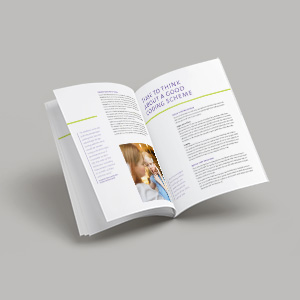How do parenting practices relate to children’s nutrition risk?

Nutrition plays a vital role in children’s growth, development, and health. Researcher Walton and her team observed family mealtimes to gain a better understanding of children’s nutrition risk.
Posted by
Published on
Tue 20 Aug. 2019
Nutrition plays a vital role in children’s growth, development, and health. Good nutrition supports their cognitive development and decreases the risk for many diseases, including diabetes and heart disease. Sadly, millions of children around the world suffer from malnutrition.
Malnutrition occurs in different forms, ranging from shortages in food intake or specific nutrients to overweightness and obesity. Because dietary patterns develop early in life, improving eating behaviors in young children is key to preventing malnutrition.
Food parenting practices
As the primary source of influence in young children’s lives, it has been suggested that parents play an important role in establishing healthy eating patterns. Indeed, evidence suggests that food parenting practices are related to children’s dietary intake and nutrition risk.
However, findings in this field of study are inconsistent. For example, while some studies indicate that restricting access to unhealthy foods results in higher intakes of these foods, others show more favorable results for restrictive parenting.
Recent scientific reviews suggest that these inconsistencies may be due to methodological limitations.
First, research in this area relies mostly on parents’ own reports on food parenting. Factors like inaccurate recall or social desirability bias may limit the validity of these measurements.
Second, these studies are often conducted in a laboratory setting. It is plausible that eating behaviors are different in the home environment, where parents are present during mealtimes and various family interactions can occur.
Nutrition risk
Researcher Walton and her colleagues addressed these limitations by conducting an observational study in families’ homes. Their aim was to study parenting practices during mealtimes and explore their relation with nutrition risk and nutritional status.
Specifically, they hypothesized that controlling and pressuring parenting practices would result in a higher child nutrition risk. They also predicted that positive encouragement during meals would be associated with a lower risk.
Moreover, they examined whether family functioning influenced these results. Family functioning describes how family members manage daily routines, communicate with each other, and connect to one another emotionally.
Lastly, they were also interested in food parenting differences between mothers and fathers.
Observing family meals
The research team included 73 families in their study, each with children between 1.5 and 5 years old. Families were asked to record three “typical” evening meals with a video camera. After each recording session, the primary parent was asked to report on food parenting practices, aspects of their home environment, and their child’s nutrition.
Parent behaviors were observed and coded using The Observer XT. The software package was also used to calculate coders’ intra-rater and inter-rater reliability.
Behaviors were coded according to the Family Mealtime Coding System (FMCS). This coding system maps different methods in food parenting, including pressure to eat, physical prompts, verbal and physical restriction, food and non-food rewards, and positive comments about food.
As a measure of nutritional status, the researchers also studied children’s body mass index (BMI).
Mothers and fathers
To gain a better understanding of different parenting practices, all data was analyzed separately for mothers and fathers.
Among mothers, more frequent physical restriction – moving a specific food away from the child - was associated with a higher nutrition risk in their children. On the other hand, more frequent positive comments about the child’s food were associated with a lower nutrition risk.
These results remained significant after controlling for family functioning and were in line with the researchers’ predictions.
When examining fathers, positive comments about their child’s food were also associated with a lower nutrition risk. However, these results were no longer significant after adjusting for family functioning.
No relations were found between food parenting practices and child BMI.
What works?
Overall, findings from this study suggest that controlling parenting practices work adversely in establishing a healthy eating pattern in children.
Earlier research suggests that this is the case because parental restriction undermines a child’s ability to recognize and respond to internal cues of hunger and satiety.
The results also indicate that positive commenting, especially regarding the child’s food, may help to reduce young children’s nutrition risk.
Strengths & limitations
The current study differed from earlier research by using direct observation, studying eating behaviors in a home environment, and including fathers as well as mothers. The research team also made an effort to study “typical” mealtimes and used a validated screening tool to assess nutritional risk (NutriSTEP ®).
A few limitations should also be mentioned. For example, the final sample for analysis included mostly families with a low nutrition risk, high family functioning, and highly educated parents, limiting the generalizability of the results.
Furthermore, most reports on nutritional risk were made by mothers, which may explain why the researchers found limited associations in the fathers’ group.
Finally, the research team did not account for multiple comparisons.
Taken together, the findings from this study should be interpreted with caution, but nevertheless provide new insights and methodologies in the field of feeding research.
Results from studies like these help support the development of interventions for families with higher nutrition risk and can help to reduce malnutrition in young children.
References
- Walton, K.; Haycraft, E.; Jewell, K; Breen, A.; Simpson J.; Haines, J. (2019). The family mealtime observation study (FaMOS): exploring the role of family functioning in the association between mothers’ and fathers’ food parenting practices and children’s nutrition risk. Nutrients, 11, 630-643.
- https://www.who.int/en/news-room/fact-sheets/detail/malnutrition
Related Posts

Understanding behavioral psychology with The Observer XT

Round Robin design: a pragmatic approach to dyadic interaction research


